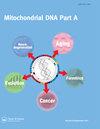保守的蜂群掩盖了一个高度分化的线粒体- coi基因在一个澳大利亚无刺蜂(膜翅目:蜂科)的物种复合体中
IF 0.6
4区 生物学
Q4 GENETICS & HEREDITY
引用次数: 11
摘要
carbonaria, Tetragonula davenporti, Tetragonula hockingsi和Tetragonula mellipes组成了澳大利亚无刺蜂的一个物种复合体,被称为“carbonaria”群。该物种在形态上难以区分,主要的物种定义特征与蜂巢结构和巢口装饰有关。该群体的分类因可能的核线粒体假基因(numts)和种间杂交而进一步复杂化。在此,我们证明了COI基因的存在,并在T. carbonaria和T. hockkingsi中分离和表征了“真正的”mt-COI基因。从富集的核DNA提取中分离出Numts,然后进行PCR扩增和Sanger测序,并通过翻译序列中存在缺失和/或过早停止密码子来识别。mt-COI序列采用纯化的mtDNA进行NGS测序。在T. carbonaria中鉴定到2个numt1和numt2,在T. hockkingsi中鉴定到第3个numt3。Numt2和numt3相似(1.2%的序列差异),表明它们是近期的共同起源。在近缘种中,两种四角虫的mt-COI遗传距离为16.5%,高于预期,证实了前人将T. carbonaria和T. hockkingsi视为独立种的研究结果。这3种蜜蜂的COI与其他无刺蜜蜂的COI(81.7 ~ 83.9%)更接近,包括澳大利亚Austroplebia australis和南美Melipona bicolor,而与本种的mt-COI(70 ~ 71.4%)更接近。这是因为carbonaria和T. hockkingsi的mt-COI与其他Meliponinae有很大的不同。我们的发现解释了炭黑菌生物地理学的一些以前令人困惑的方面,以及误解的放大。本文章由计算机程序翻译,如有差异,请以英文原文为准。
Conserved numts mask a highly divergent mitochondrial-COI gene in a species complex of Australian stingless bees Tetragonula (Hymenoptera: Apidae)
Abstract Tetragonula carbonaria, Tetragonula davenporti, Tetragonula hockingsi and Tetragonula mellipes comprise a species complex of Australian stingless bee species known as the ‘Carbonaria’ group. The species are difficult to distinguish morphologically and the major species-defining characters relate to comb architecture and nest entrance ornamentation. The taxonomy of the group is further complicated by likely nuclear mitochondrial pseudogenes (numts) and inter-specific hybrids. Here we demonstrate the existence of COI numts and isolate and characterize the ‘true’ mt-COI gene in T. carbonaria and T. hockingsi. Numts were isolated from enriched-nuclear DNA extraction followed by PCR amplification and Sanger sequencing, and were recognized by the presence of deletions and/or premature stop codons in the translated sequences. The mt-COI sequences were obtained from NGS sequencing using purified mtDNA. In T. carbonaria, two numts (numt1 and numt2) were identified and a third (numt3) was identified in T. hockingsi. Numt2 and numt3 are similar (1.2% sequence divergence), indicating a recent common origin. The genetic distance between the mt-COI of the two Tetragonula species was higher than might be expected for closely related species, 16.5%, corroborating previous studies in which T. carbonaria and T. hockingsi were regarded as separate species. The three numts are more similar to the COI of other stingless bee species, including Australian Austroplebia australis and South American Melipona bicolor (81.7–83.9%) than to the mt-COI of their own species (70–71.4%). This is because the mt-COI of T. carbonaria and T. hockingsi differ greatly from other Meliponinae. Our findings explain some formerly puzzling aspects of Carbonaria biogeography, and misinterpreted amplifications.
求助全文
通过发布文献求助,成功后即可免费获取论文全文。
去求助
来源期刊

Mitochondrial Dna Part a
Biochemistry, Genetics and Molecular Biology-Genetics
CiteScore
3.00
自引率
0.00%
发文量
6
期刊介绍:
Mitochondrial DNA Part A publishes original high-quality manuscripts on physical, chemical, and biochemical aspects of mtDNA and proteins involved in mtDNA metabolism, and/or interactions. Manuscripts on cytosolic and extracellular mtDNA, and on dysfunction caused by alterations in mtDNA integrity as well as methodological papers detailing novel approaches for mtDNA manipulation in vitro and in vivo are welcome. Descriptive papers on DNA sequences from mitochondrial genomes, and also analytical papers in the areas of population genetics, phylogenetics and human evolution that use mitochondrial DNA as a source of evidence for studies will be considered for publication. The Journal also considers manuscripts that examine population genetic and systematic theory that specifically address the use of mitochondrial DNA sequences, as well as papers that discuss the utility of mitochondrial DNA information in medical studies and in human evolutionary biology.
 求助内容:
求助内容: 应助结果提醒方式:
应助结果提醒方式:


